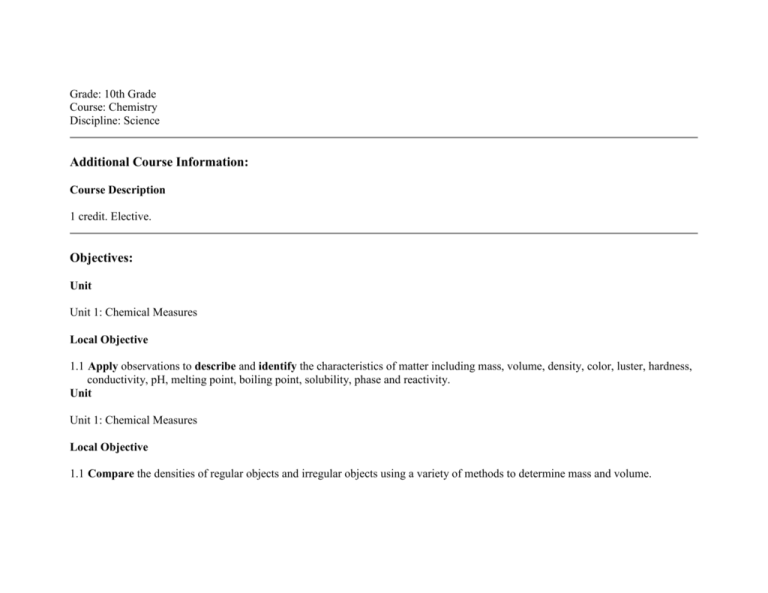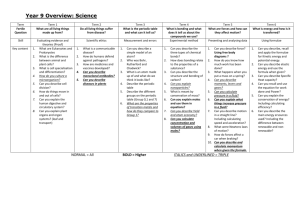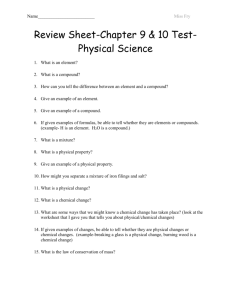Grade: 10th Grade
advertisement

Grade: 10th Grade Course: Chemistry Discipline: Science Additional Course Information: Course Description 1 credit. Elective. Objectives: Unit Unit 1: Chemical Measures Local Objective 1.1 Apply observations to describe and identify the characteristics of matter including mass, volume, density, color, luster, hardness, conductivity, pH, melting point, boiling point, solubility, phase and reactivity. Unit Unit 1: Chemical Measures Local Objective 1.1 Compare the densities of regular objects and irregular objects using a variety of methods to determine mass and volume. Unit Unit 1: Chemical Measures Local Objective 1.1 Analyze qualitative and quantitative observations to determine appropriate significant figures and scientific notation when making measurements and gathering data, and judge whether measurements, computations, and data sets are reasonable. Unit Unit 2: Energy Local Objective 2.1 Classify various materials as either matter or energy and identify what evidence there is for your decision. Unit Unit 2: Energy Local Objective 2.2 Compare and contrast physical and chemical changes in matter including phase changes and how energy effects each phase. Unit Unit 2: Energy Local Objective 2.3 Describe sources and uses for the different forms of energy including chemical, nuclear, thermal, mechanical, and electromagnetic, and debate the advantages and disadvantages of using each. Unit Unit 2: Energy Local Objective 2.5 Describe and Identify exothermic and endothermic reactions. Unit Unit 2: Energy Local Objective 2.4 Differentiate between heat, temperature, and thermal energy. Unit Unit 3: Matter and the Atom Local Objective 3.2 Describe the electron configuration of an atom using Bohr’s model and the Quantum mechanical model to describe the visible light emitted from excited molecules. Unit Unit 3: Matter and the Atom Local Objective 3.1 Illustrate the modern theory of the atom including the positive dense nucleus and the negative electron cloud, and identify the parts and number of the subatomic particles including the protons, neutrons and electrons. Unit Unit 4: Periodic Table Local Objective 4.3 Predict the properties of an element from its position on the periodic table including types of bonds, reactivity, and physical characteristics. Unit Unit 4: Periodic Table Local Objective 4.1 Compare and Contrast the properties of the families on the periodic table of elements. Unit Unit 4: Periodic Table Local Objective 4.2 Describe an atom’s subatomic particles by using the atomic mass and atomic number and identify the results differing numbers will create. (Isotopes, Ions) Unit Unit 5: Bonding Local Objective 5.2 Create Lewis Dot Diagrams to show how and why specific atoms bond the way they do. Unit Unit 5: Bonding Local Objective 5.1 Compare and Contrast the types of bonds that can be formed and describe how each bond relates to electrons and electronegativities. Unit Unit 6: Chemical Reactions Local Objective 6.1 Balance chemical equations and recognize that a balanced number of products and reactants in a reaction reemphasize the Law of Conservation of Mass. Unit Unit 6: Chemical Reactions Local Objective 6.2 Identify the products of a reaction according to a half reaction and knowledge of the types of reactions. Unit Unit 6: Chemical Reactions Local Objective 6.3 Translate chemical sentences using proper nomenclature into formal chemical equations. Unit Unit 7: Chemical Reactions Local Objective 7.4 Predict the rates of reactions based on the properties of the reactants in a reaction. Unit Unit 7: Solutions Local Objective 7.1 Classify solutions or mixtures as dilute, concentrated, saturated, or supersaturated. Unit Unit 7: Solutions Local Objective 7.2 Compare and contrast the properties of acid, base and neutral solutions. Unit Unit 7: Solutions Local Objective 7.3 Predict the properties of the solvent or solute on the solubility of a substance.











